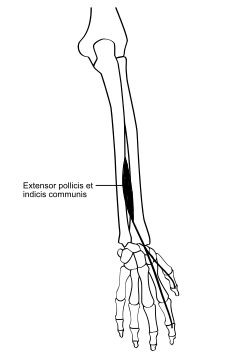Extensor pollicis et indicis communis muscle
In human anatomy, the extensor pollicis et indicis communis is an aberrant muscle in the posterior compartment of forearm. It was first described in 1863.[1] The muscle has a prevalence from 0.5% to 4%.[2]
| Extensor pollicis et indicis communis | |
|---|---|
 Extensor pollicis et indicis communis muscle | |
| Details | |
| Origin | Posterior distal third of ulna and interosseous membrane |
| Insertion | thumb (extensor hood) and index finger (extensor hood) |
| Artery | posterior interosseous artery |
| Nerve | posterior interosseous nerve |
| Actions | extends thumb and index finger |
| Identifiers | |
| Latin | Musculus extensor pollicis et indicis communis |
| Anatomical terms of muscle | |
Structure
The structure of the extensor pollicis et indicis communis resembles both the characteristics of the extensor pollicis longus and the extensor indicis proprius. It originates from the distal end of ulna. Its tendon passes through the extensor retinaculum in the fourth extensor compartment, splits into two and inserts to both thumb and index finger. The presence of the extensor pollicis et indicis communis, on the other hand, may impair thumb adduction.[3]
It was reported as an unusual juncturae tendinum, a tendinous connection between tendon of the extensor pollicis longus and tendon of the extensor digitorum communis to the index finger.[4] It was also identified as a slip of the extensor indicis proprius to the extensor pollicis longus in an Indian cadaver.[5]
In other animals
In many species of New World monkeys, a muscle similar to the extensor pollicis et indicis communis was found to be a normal anatomy rather than an anatomical variation.[6] It is described as the extensor pollicis et indicis longus.[6] In chimpanzees and humans, however, the muscle is well separated becoming the extensor pollicis longus and the extensor indicis proprius.[7]
See also
- List of anatomical variations
- Extensor pollicis longus
- Extensor indicis proprius
References
- Wood, J. (1863-01-01). On Some Varieties in Human Myology. Royal Society of London.
- Martínez, Daniel Casanova; Gandur, Iván Valdivia; Golanó, Pau (2012-12-20). "Extensor pollicis et indicis communis or extensor indicis radialis muscle". Anatomical Science International. 88 (3): 153–155. doi:10.1007/s12565-012-0164-8. ISSN 1447-6959. PMID 23255266.
- Komiyama, M.; Nwe, T. M.; Toyota, N.; Shimada, Y. (1999-10-01). "Variations of the extensor indicis muscle and tendon". Journal of Hand Surgery (Edinburgh, Scotland). 24 (5): 575–578. doi:10.1054/jhsb.1999.0239. ISSN 0266-7681. PMID 10597935.
- Steichen, J. B.; Petersen, D. P. (1984-09-01). "Junctura tendinum between extensor digitorum communis and extensor pollicis longus". The Journal of Hand Surgery. 9 (5): 674–676. doi:10.1016/s0363-5023(84)80011-8. ISSN 0363-5023. PMID 6491210.
- Bolwar, Preeti R. (2011). "A study of anatomical variations of the extensor tendons of the index finger and their significance". Eur J Anat. 15: 129–135.
- Schön, Miguel A. (1968-01-01). The muscular system of the red howling monkey. Smithsonian Institution Press; [for sale by the Supt. of Docs., U.S. Govt. Print. Off.]
- Aversi-Ferreira, T. A.; Diogo, R.; Potau, J. M.; Bello, G.; Pastor, J. F.; Aziz, M. Ashraf (2010-12-01). "Comparative anatomical study of the forearm extensor muscles of Cebus libidinosus (Rylands et al., 2000; Primates, Cebidae), modern humans, and other primates, with comments on primate evolution, phylogeny, and manipulatory behavior". Anatomical Record. 293 (12): 2056–2070. doi:10.1002/ar.21275. ISSN 1932-8494. PMID 21082733.